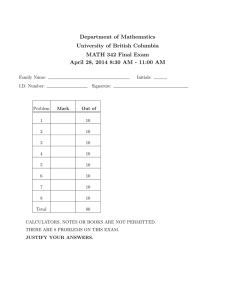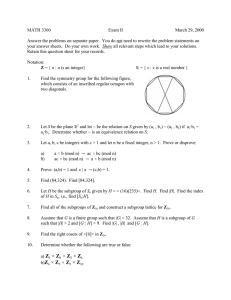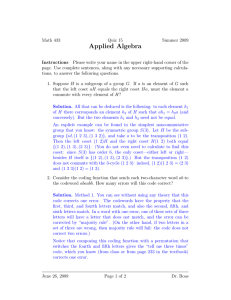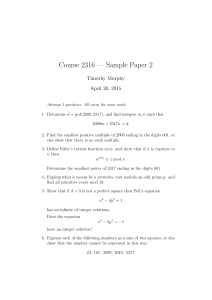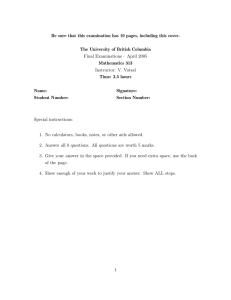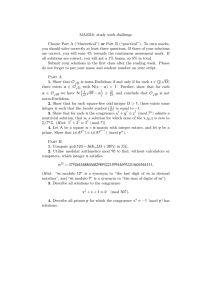Department of Mathematics University of British Columbia MATH 342 Practice Final Exam
advertisement
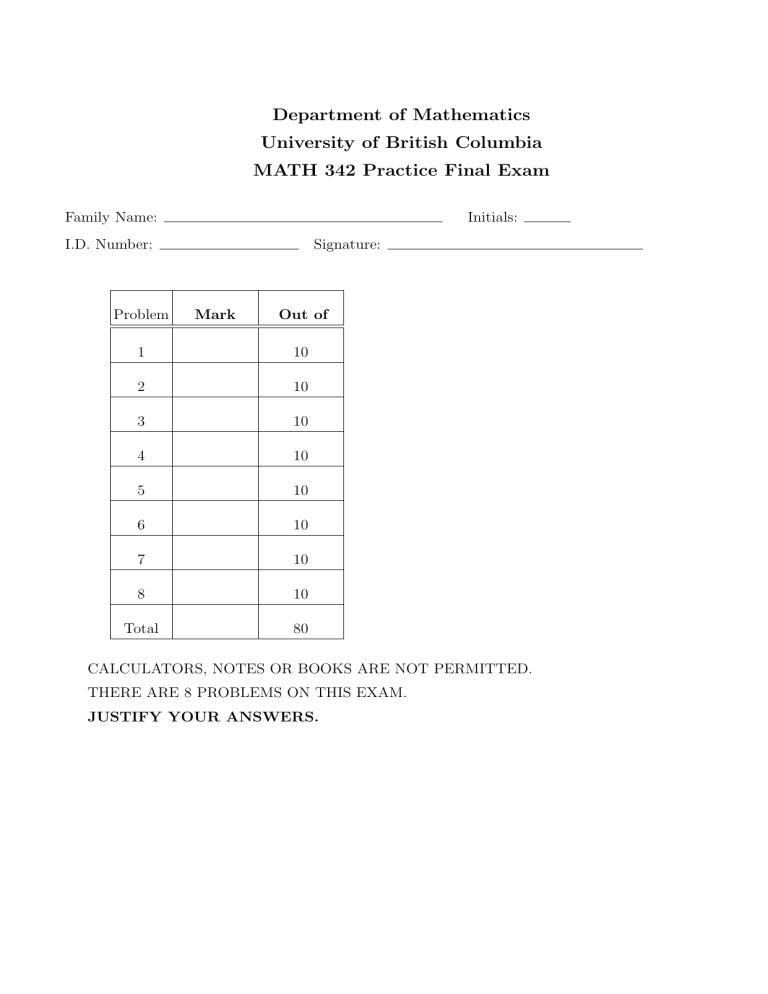
Department of Mathematics
University of British Columbia
MATH 342 Practice Final Exam
Family Name:
Initials:
I.D. Number:
Problem
Signature:
Mark
Out of
1
10
2
10
3
10
4
10
5
10
6
10
7
10
8
10
Total
80
CALCULATORS, NOTES OR BOOKS ARE NOT PERMITTED.
THERE ARE 8 PROBLEMS ON THIS EXAM.
JUSTIFY YOUR ANSWERS.
MATH 342
Math 342 Practice Final Exam
2
1.
Find the following principal remainders, (the principal remainder of
a mod q is the unique element b ∈ {0, 1, . . . , q − 1} s.t. a = b mod q).
(a) 103849197491 mod 11
(b) (60)11 mod 11
(c) (1100005)(223347) mod 11
solution:
a. 10 = −1 mod 11. Since the exponent is odd, the answer is −1 = 10
mod 11.
b. By Fermat’s little Theorem, (60)11 = 60 = 5 mod 11.
c. The first factor is 5 mod 11 and the second factor is 3 mod 11 (since
11 divides 22, 33 and 44). Thus the product is equal to 15 = 4 mod 11.
MATH 342
Math 342 Practice Final Exam
3
MATH 342
Math 342 Practice Final Exam
4
2.
Let C be the linear code over GF (5) spanned by {01234, 13024, 12340}.
(a) Find bases for C and C ⊥.
(b) Find the length, dimension, and minimum distance of C and C ⊥.
(c) Find the number of cosets of C and C ⊥.
(d) For each coset of C ⊥ with coset leader of weight at least 2, find a
coset leader.
solution:
We first find a generator matrix for C by finding the REF of
0 1 2 3 4
1 3 0 2 4
1 2 3 4 0
1 3 0 2 4
0 1 2 3 4
1 2 3 4 0
1 3 0 2 4
0 1 2 3 4
0 4 3 2 1
1 3 0 2 4
0 1 2 3 4
0 0 0 0 0
So, a generator matrix is
1 3 0 2 4
G=
0 1 2 3 4
We can put this in standard form by reducing to RREF:
1 0 4 3 2
G0 =
0 1 2 3 4
MATH 342
Math 342 Practice Final Exam
5
So a basis for C is {10432, 01234}.
A parity check matrix for C is
−4 −2 1 0 0
1 3 1 0 0
H = −3 −3 0 1 0 = 2 2 0 1 0
−2 −4 0 0 1
3 1 0 0 1
So a basis for C ⊥ is {13100, 22010, 31001}.
b. Using the fact that H is a parity check matrix for C and G0 is a
parity check matrix for C ⊥, we see that C is a [5, 2, 4] code and C ⊥ is
a [5, 3, 3] code (for the latter, observe that the first 3 columns of G0 are
linearly dependent; for the former observe that the determinant of each
matrix consisting of three columns of H is nonzero – argue by cases).
c. C has 55−2 = 125 cosets and C ⊥ has 55−3 = 25 cosets.
d. Since d(C ⊥) = 3, all words of weight 0 or 1 are coset leaders. There
are 21 such words. The 4 remaining coset leaders correspond to syndromes that are not multiples of single columns of G0 and not the zero
vector. These syndromes are the multiples of the vector [41]. The vector
x := [41000] has syndrome [41] and since x has weight two, it can be
chosen as a coset leader for its coset. The other coset leaders are the
nonzero multiples of x, namely [32000], [23000], [14000].
MATH 342
Math 342 Practice Final Exam
6
3.
A subgroup H of a group G is proper if H 6= G.
(a) Find all proper subgroups of Z4 (with addition modulo 4).
(b) Find all proper subgroups of GF (4) (with addition).
Recall the addition table for GF (4):
+
0
1
a
b
0
0
1
a
b
1
1
0
b
a
a
a
b
0
1
b
b
a
1
0
solution:
The identity element must be an element of every subgroup.
a. Z4 = {0, 1, 2, 3}. So any subgroup H must contain 0. If H contains
1, then it must also contain 2 and 3 and thus is not a proper subgroup.
Similarly, if it contains 3, it must also contain 1 and 2. The only other
possibility is H = {0, 2} which is a proper subgroup. So the only proper
subgroups are {0} and {0, 2}.
b. GF (4) = {0, 1, a, b}. Since every element is its own inverse and
the sum of any element and itself is 0, each of {0, 1}, {0, a} and {0, b}
is a proper subgroup. If a subgroup contains two of the three nonzero
elements it must contain the third nonzero element. So the only proper
subgroups are {0}, {0, 1}, {0, a}, {0, b}.
MATH 342
Math 342 Practice Final Exam
7
4.
Which of the following polynomials is (are) irreducible over GF (2)?
(a) f (x) = x5 + x2 + 1
(b) g(x) = x5 + x + 1
solution:
a. Irreducible: There are no degree-one factors since neither x = 0 nor
x = 1 is a root. So, it is irreducible iff it has a quadratic factor. The
quadratic polynomials are {x2, x2 + 1, x2 + x, x2 + x + 1}. The first and
third of these are divisible by x, but f (x) is not. So, the only possible
factors are x2 + 1 and x2 + x + 1. By long division, the first gives the
non-zero remainder, x, and the second gives the non-zero remainder, 1.
b. Reducible: Using the same procedure, g(x) is irreducible iff x2 + 1
and x2 +x+1 do not divide it. But x2 +x+1 does divide it: x5 +x+1 =
(x3 + x2 + 1)(x2 + x + 1).
MATH 342
Math 342 Practice Final Exam
8
MATH 342
Math 342 Practice Final Exam
9
5.
Recall the definition of characteristic of a finite field F : the smallest
positive integer q such that q · 1 = 0 (recall that for an element a ∈ F ,
q · a denotes the sum of q copies of a).
(a) Show that if F is a finite field with characteristic q, then for all
nonzero elements a ∈ F , q is the smallest positive integer such that
q·a=0
(b) For any prime p and positive integer n, what is the characteristic of
GF (pn)?
solution:
a. Let a be a nonzero element of F . Let q be a positive integer. If
q · a = 0, then (q · 1)a = q · a = 0. Since F is a field and a 6= 0,
(q · 1) = 0. Conversely, if (q · 1) = 0, then (q · a) = 0. Thus, (q · a) = 0
iff (q · 1) = 0. So, the characteristic of F is the smallest positive integer
q s.t. (q · a) = 0.
b. We proved in class that the characteristic of GF (p) (which is the
same as Zp) is p. Now GF (pn) = GF (p)[x]/(f (x)) where f (x) is an
irreducible polynomial over GF (p). The multiplicative identity element
of GF (pn) is the same as the multiplicative identity element, 1, of GF (p).
For a positive integer q, the expression q · 1 means the same in GF (pn)
as in GF (p). So, the characteristic of GF (pn) is p.
MATH 342
Math 342 Practice Final Exam
10
MATH 342
Math 342 Practice Final Exam
11
6.
Let a be a primitive element of GF (27).
(a) Find all positive integers n such that an = a3.
(b) Find all powers of a that are primitive.
solution:
a. Since a is primitive it is nonzero. So, a26 = 1. Since the powers ai,
i = 1, . . . , 26 exhaust all of GF (27) \ {0} and a26 = 1, we have that
k = 26 is the only positive integer in the range [1, 26] such that ak = 1.
Thus, am = 1 iff m is a multiple of 26. Since an = a3 iff an−3 = 1, we
have an = a3 iff n = 3 mod 26.
b. Let g := gcd(m, 26). If g 6= 1, then 26/g < 26 and since (am)26/g =
(a26)m/g = 1, am is not primitive (because (am)26/g = 1 and (am)26 =
(a26)m = 1 and so the first 26 powers of am cannot exhaust all of
GF (27) \ {0}).
If g = 1, then by Bezout, there exist integers u, v s.t. mu + 26v = 1.
Then
aum = auma26v = aum+26v = a
We claim that am is primitive. If not, then for some 1 ≤ i < 26,
(am)i = 1. But then ai = (aum)i = (ami)u = 1u = 1, a contradiction to
the fact that a is primitive.
So, am is primitive iff g = 1 iff m is not congruent to an even integer or
13 mod 26.
MATH 342
Math 342 Practice Final Exam
12
MATH 342
Math 342 Practice Final Exam
13
7.
In this problem, note the “round brackets” (n, M, d) (not square brackets [n, k, d]).
(a) i. Find a (3,4,2) binary code.
ii. Find a (5,4,3) binary code.
iii. Usse parts i and ii to find a (8,4,5) binary code.
(b) Show that A2(8, 5) = 4.
solution:
a.
i. {000, 011, 101, 110}
ii. {00000, 01101, 10110, 11011}
iii. {00000000, 01101011, 10110101, 11011011}
b. By part a, we know that A2(8, 5) ≥ 4. So, it suffices to show that
there does not exist a binary code of length 8, minimum distance 5 with
5 codewords.
Suppose that C is an (8, 5) code with 5 codewords. Up to equivalence,
we may assume that C contains 0. Thus, the other four codewords must
have weight at least 5.
If C contains a word x of weight 7 or 8, then any other word y of
weight at least 5 would share at least 4 1’s in the same positions and so
d(x, y) ≤ 4, a contradiction. So, the remaining words of C must have
weight 5 or 6.
Suppose that C contains two words u and v of weight 6. They must share
at least 4 1’s in the same positions and so d(u, v) ≤ 4, a contradiction.
So, C contains at most one word of weight 6. Thus, it must contain at
least three words of weight 5.
MATH 342
Math 342 Practice Final Exam
14
Up to equivalence, we may assume that one of these words is z =
11111000. If z 0 is another word of weight 5, then z and z 0 must share
at least 2 1’s in the same positions (otherwise z 0 would not have weight
5). Suppose that they share at least 3 1’s in the same positions. Then
they must differ in the other 5 positions. But this is impossible since
they both have weight 5. Thus, z 0 must share exactly 2 1’s in the same
positions as z. If z 00 were another such word then it would also share
exactly 2 1’s in the same positions as z. Since z, z 0 have weight 5, they
must both have 1’s in the last 3 positions. Since they differ in 5 positions
they must be of the form: z 0 = x1x2x3x4x5111 and z 00 = xc1xc2xc3xc4xc5111.
Since z 0 has weight 5, z 00 would have weight 6, a contradiction.
Thus, there can be only two words of weight 5, a contradiction.
MATH 342
Math 342 Practice Final Exam
15
8.
Let C be a binary code of length n with at least two codewords. Let t be
a positive integer such that the Hamming balls of radius t, centered at
the codewords, are pairwise disjoint and completely cover V (n, 2). Show
that d(C) = 2t + 1.
solution:
To show that d(C) = 2t + 1, we must show:
i. for all pairs of distinct codewords c, c0, d(c, c0) ≥ 2t + 1.
ii. there exists a pair of codewords c, c0 such that d(c, c0) = 2t + 1.
Proof of (i): Suppose not. Then there exists a pair of distinct codewords
c, c0 such that d(c, c0) ≤ 2t. If d(c, c0) ≤ t, then c0 ∈ Bt(c), contrary
to the assumption that the Hamming balls of radius t centered at the
codewords are pairwise disjoint. If not, then t < d(c, c0) ≤ 2t. Let x
be obtained from c by swapping 0 and 1 in exactly t positions where c
and c0 disagree. Then d(c, x) = t and d(c0, x) = 2t − d(c, c0) < t, again
contrary to he assumption that the hamming balls of radius t centered
at the codewords are pairwise disjoint.
Proof of (ii): Let c ∈ C and let x be obtained from c by swapping 0
and 1 in exactly t + 1 bit positions. Then x 6∈ Bt(c). But since the
Hamming balls of radius t cover V (n, 2), x ∈ Bt(c0) for some c0 ∈ C.
Clearly c 6= c0. Then
d(c, c0) ≤ d(c, x) + d(x, c0) ≤ (t + 1) + t = 2t + 1.
By part (i), d(c, c0) = 2t + 1.
MATH 342
Math 342 Practice Final Exam
16
